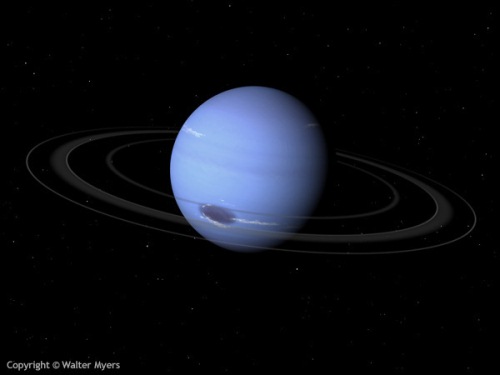

Neptune’s inner moons (red), rings and arcs (green), here shown to scale. “This pair of satellites provides a dramatic illustration that moons are sometimes broken apart by comets.” “Based on estimates of comet populations, we know that other moons in the outer solar system have been hit by comets, smashed apart, and re-accreted multiple times,” Lissauer said. This is the first evidence that a moon in the solar system is a castoff from a comet collision with a much larger parent body. Showalter and colleagues Imke de Pater, a UC Berkeley professor of astronomy, and Jack Lissauer of NASA’s Ames Research Center in Mountain View, think that the impact kicked out a little piece of Proteus that has slowly migrated away from the parent body. The key came from earlier pictures of Proteus taken in 1989 by Voyager 2 that show an impact crater almost large enough to have shattered the moon.

Yet, today, the orbits of the two moons are only 7,500 miles apart. Over time, Proteus should have gravitationally swept aside or swallowed the smaller moon while clearing out its orbital path. “In the distant past, given the slow migration outward of the larger moon, Proteus was once where Hippocamp is now.” “The first thing we realized was that you wouldn’t expect to find such a tiny moon right next to Neptune’s biggest inner moon,” said Mark Showalter of the SETI Institute in Mountain View, California. The moon was uncovered in Hubble Space Telescope photographs taken in 2013 and has puzzled astronomers ever since. They maintain the peace by never getting too close.Astronomers now think that Neptune’s tiniest moon, Hippocamp, was chipped off a larger moon, Proteus, by a cosmic collision billions of years ago. “Naiad and Thalassa have probably been locked together in this configuration for a very long time, because it makes their orbits more stable. “We are always excited to find these co-dependencies between moons,” said Showalter, who is also a co-author on the new paper. It was hidden from view during Voyager’s initial observation of Neptune and its moons. “Only later, after its orbital tilt was established, could Naiad settle into this unusual resonance with Thalassa.”Įarlier this year, Mark Showalter, a planetary astronomer at the SETI Institute, uncovered the 14th moon around Neptune called Hippocamp.

“We suspect that Naiad was kicked into its tilted orbit by an earlier interaction with one of Neptune’s other inner moons,” Brozović said. The seven inner moons, including Naiad and Thalassa that are each 60 miles long, are also interspersed with Neptune’s ring system. This is the first evidence for a moon being an offshoot from a comet collision with a much larger parent body. Only 20 miles across, it may actually be a broken-off fragment from a much larger neighboring moon, Proteus, seen as a crescent in the background. This is an artist's concept of the tiny moon Hippocamp that was discovered by the Hubble Space Telescope in 2013. They also thought these inner moons were fragmented due to impacts by comets. Since the discovery of the small inner moons, scientists have believed that they are younger than Neptune and that they formed after Neptune captured its largest moon, Triton. Some of the moons formed in place along with Neptune while others were captured by the planet’s gravity. Neptune is a gas giant distant from the sun in the outer solar system and it has 14 moons. How do they make it work? Check it out: /AU4v9fLBPo- NASA November 16, 2019 Up, up, down, down - do the Neptune Moon dance! 🕺Partners w/ chemistry AND rhythm, Moons Naiad & Thalassa are caught in a “dance of avoidance” choreographed so precisely that neither steps on the other one’s toes. “There are many different types of ‘dances’ that planets, moons and asteroids can follow, but this one has never been seen before.” “We refer to this repeating pattern as a resonance,” said Marina Brozović, study author and expert in solar system dynamics at NASA’s Jet Propulsion Laboratory. The observations of the orbital patterns were made using NASA’s Hubble Space Telescope. When Neptune got its stunning close-up: The Voyager 2 flyby, 30 years laterĪ study of these orbits published recently in the journal Icarus. North of these, a bright cloud band similar to the south polar streak may be seen. These clouds were seen to persist for as long as Voyager's cameras could resolve them. The picture shows the Great Dark Spot and its companion bright smudge on the west limb the fast moving bright feature called Scooter and the little dark spot are visible. The images were taken at a range of 4.4 million miles from the planet, 4 days and 20 hours before closest approach. This picture of Neptune was produced from the last whole planet images taken through the green and orange filters on the Voyager 2 narrow angle camera.


 0 kommentar(er)
0 kommentar(er)
